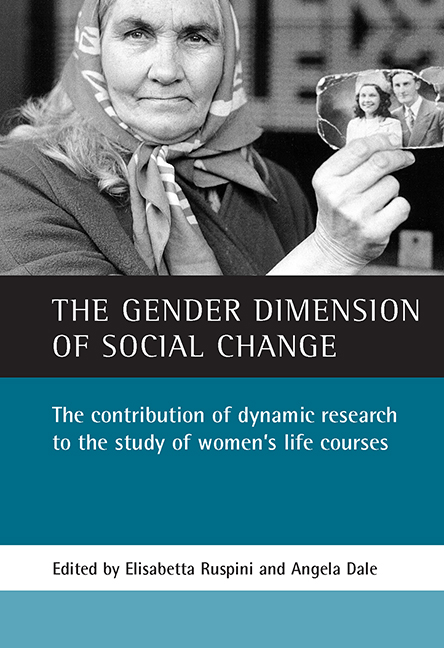 The Gender Dimension of Social Change
The Gender Dimension of Social Change ten - Longitudinal analysis and the constitution of the concept of gender
Published online by Cambridge University Press: 20 January 2022
Summary
Introduction
As the other chapters of this volume have clearly demonstrated, longitudinal analysis provides an invaluable tool for enhancing our understanding of gender differences and inequalities. One of the advantages of longitudinal analysis in examining women’s lives is that, for many women, the experience of motherhood necessitates a careful balance between responsibilities for the care of young children and maintaining an attachment to the labour market. Therefore, methodological approaches are required which will allow for an examination of women’s transitions between different labour market states and which will also enable an investigation of the long-term consequences of time spent out of the labour market and time spent in part-time work for women’s subsequent careers and for gender inequalities later in life. As Joshi and Davies emphasise in Chapter Six, the fluctuations in earnings over the life cycle experienced by many women (and particularly those with children) increases the need to take a long-term perspective. In addition, as Dex and Smith illustrate in Chapter Eight, as certain sectors of the labour market become increasingly characterised as offering temporary and insecure employment, longitudinal data are required in order to examine the different problems that men and women may face in maintaining continuity of employment.
As Ruspini has previously argued, the radically different relationship that many women have with the labour market, compared with men, means that ‘women cannot simply be “added in” to existing analyses: instead a different analytic framework is required’ (2001, p 102). Longitudinal data and longitudinal approaches to analysis clearly go some way towards providing an appropriate gender-sensitive methodology. However, as this chapter emphasises, it is important that, as the corpus of longitudinal research on women’s lives develops and allows for a greater understanding of gender inequalities, we simultaneously develop an awareness of how particular analytic tools and approaches themselves have the potential to shape the way that we think about gender.
True to the spirit of this volume, this chapter aims to illustrate the value of longitudinal data and longitudinal approaches for examining women’s lives. In particular, I will focus on the role of part-time work in the context of British women’s work histories. However, this chapter has a second and equally important aim.
- Type
- Chapter
- Information
- The Gender Dimension of Social ChangeThe Contribution of Dynamic Research to the Study of Women's Life Courses, pp. 229 - 258Publisher: Bristol University PressPrint publication year: 2002


